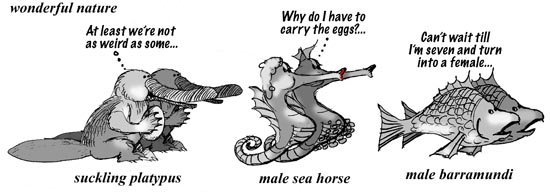Search
Recent comments
- the fallout....
13 hours 29 min ago - meanwhile....
13 hours 47 min ago - extortion....
14 hours 10 min ago - death wish....
14 hours 14 min ago - heroes....
14 hours 48 min ago - joining fools....
15 hours 6 min ago - humanely....
15 hours 13 min ago - putin's pudding....
15 hours 22 min ago - hungry war.....
15 hours 34 min ago - EU panics....
15 hours 39 min ago
Democracy Links
Member's Off-site Blogs
some mothers do have 'em .....

With a bill like a duck, a tail and fur like a beaver and snake-like venom hidden in heel spurs, the platypus could be the result of some strange genetic experiment.
It is: evolution.
Scientists on Thursday published the genetic makeup of the Australian animal in the scientific journal Nature, confirming that its multifaceted features are reflected all the way down to its DNA.
The research could help explain how mammals, including humans, evolved from reptiles millions of years ago, they said.
"At first glance, the platypus appears as if it was the result of an evolutionary accident," said Francis S. Collins, director of the U.S. National Human Genome Research Institute, which funded the study.
-------------------
Gus: Hey, we're all evolutionary accidents... Gees!... Want proof? Just look at Dubya... Yep some evolutionary accidents seem to go in the wrong direction. But that's only a value judgment on the way the brain of sponges work.Scientists Map The Genome Of The Platypus, One Of Nature's Strangest Animals
- By Gus Leonisky at 9 May 2008 - 7:05am
- Gus Leonisky's blog
- Login or register to post comments
wildly endangered
Endangered species could become extinct 100 times faster than previously thought, scientists warned yesterday in a bleak reassessment of the threats to global biodiversity. They say methods used to predict when species will die out are seriously flawed and dramatically underestimate the speed at which some will disappear.
The findings, presented in the journal Nature, suggest that animals such as the western gorilla, the Sumatran tiger and Malayan sun bear, the smallest of the bear family, may become extinct much sooner than conservationists had feared.
Ecologists Brett Melbourne, at the University of Colorado at Boulder, and Alan Hastings at the University of California, Davis said conservation organisations should use updated extinction models to urgently re-evaluate the risks to wildlife. "Some species could have months instead of years left, while other species that haven't even been identified as under threat yet should be listed as endangered," said Melbourne.
The warning has particular implications for the International Union for Conservation of Nature (IUCN), which compiles an annual "red list" of endangered species. Last year the list upgraded western gorillas to critically endangered, after populations of a subspecies were found to have been badly affected by Ebola virus and the commercial trade in bushmeat.